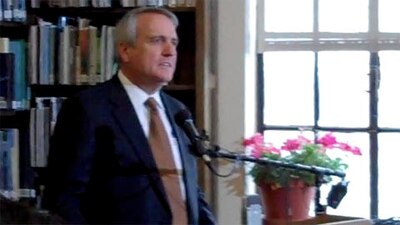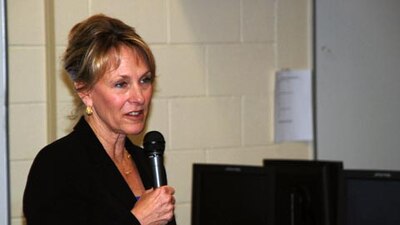State officials Tuesday filed their 152-page application (not counting appendices) for $377 million in federal Race to the Top funds, insisting that the plan sets the path for further education reform even if Colorado doesn’t win a federal grant.
A key element of the plan, an executive order creating a 15-member Governor’s Council for Educator Effectiveness, also dramatically changes the education landscape in the 2010 legislature, making it less likely that any major teacher effectiveness legislation will be passed this year.

The new council is charged with developing definitions of principal and teacher effectiveness and guidelines for a new educator evaluation system. But, the council won’t have to make any recommendations for legislation until Sept. 30, 2011.
Freshman Sen. Michael Johnston, D-Denver, has been developing comprehensive educator evaluation and tenure legislation for this year. He told EdNews Tuesday that Ritter’s plan is similar in many ways to his and that he’ll have to reconsider what legislation he’ll introduce.
The R2T program, part of the American Recovery and Reinvestment Program passed by Congress last year, offers some $4 billion in competitive grants to states for improvements in four broad areas – teacher and principal effectiveness, performance at struggling schools, modern data systems and better assessment tools.
Highlights of Colorado proposal include:
- Creation of the Colorado Center for Educator Excellence, a non-profit charged with researching teacher performance measured by student growth and disseminating best practices.
- Establishment of the Educator Effectiveness Office, a state-level unit to provide technical assistance to school districts in developing and implementing new educator evaluation and effectiveness management systems.
- Identification, development and implementation of high-quality evaluation systems in all participating school districts without such systems by 2012-13. Each district would receive two staffers to implement the system and to provide training and support to teachers and principals.
- Expansion of Teach for America’s Colorado workforce to more than 800 teachers and use of its tools for using student growth data to evaluate teacher effectiveness.
- Identification of a select group of highly effective teachers on the basis of student growth data and award of $10,000 grants to each teacher and matching grants to their schools for use of those classrooms as models for other educators.
- Creation of the Colorado Turnaround Center, a non-profit overseen by the state that would build the supply of school operators, share knowledge about successful strategies and mobilize supports for children in failing schools.
- Establishment of an integrated statewide data system that links information about students from preschool into college, using data from a variety of public agencies.
According to education Commissioner Dwight Jones, the application requests $45 million to help low-performing schools, $21 million for development of an educator evaluation system and $15 million for standards and assessments.

Colorado’s application was developed starting last summer using state employees, consultants and hundreds of volunteers who participated in four volunteer committees. Lt. Gov. Barbara O’Brien led the state’s effort.
U.S. Department of Education R2T requirements (which were a moving target at times last year) urged states to get the widest possible support for their applications. In Colorado, 134 school districts representing 94 percent of state students formally signed on to the application. (In recent months Jones led an intense effort to recruit districts, which will receive half of the funds Colorado might win.) In 35 districts, teacher bargaining units also signed on to the application, with the major exceptions of Aurora and Cherry Creek.
The months of work were capped by the Tuesday morning news conference in the historic restored library of Denver’s East High School. Ritter, O’Brien and Jones were joined by dozens of legislators, state officials, education advocates and students, including members of Project VOYCE, a student group that participated in the planning.
“Colorado has been racing to the top for years,” Ritter said. “This proposal will accelerate our reforms of the last three years and give Colorado a blueprint for future reforms regardless of whether we secure a Race to the Top grant. The collaborative approach – the involvement of hundreds of education stakeholders from across Colorado – again demonstrates our statewide commitment to improving student learning and helping good teachers become great teachers.”
Businessman Zach Neumeyer, who’s been active on education issues, and Colorado
Education Association President Beverly Ingle also spoke in support of the application. The event was long on praise for all involved in the effort and short on details of the plan.
The biggest surprise in the application was the Council for Educator Effectiveness created by Ritter’s executive order.
State education leaders have repeatedly acknowledged that Colorado is weakest in the area of educator effectiveness. The 2008 and 2009 legislative sessions passed important education reforms in the areas of standards, testing, P-20 alignment and school and district accountability. Last year lawmakers also approved creation of an educator identifier system that ultimately can be used to link teachers and principals with student achievement data.
Legislation on educator evaluation and tenure was expected to be the major education issue of the 2010 session, but that effort appears to have been preempted by Ritter’s new council.
Its 15 members, 11 of whom will be appointed with the advice of interest groups ranging from the CEA to the statewide PTA, have a deadline of Dec. 31 to recommend statewide definitions of teacher and principal effectiveness. It has the same deadline to “develop and recommend guidelines for implementation of a high-quality educator evaluation system.”
The executive order requires that council make recommendations about policy changes and legislation “on or before” Sept. 30, 2011, to the governor, legislature and State Board of Education. Such recommendations can include those that will “support districts’ use of evaluation data for decisions in areas such as compensation, promotion, retention and removal, as well as the criteria for earning and retaining non-probationary status.”
The executive order calls for ensuring that educators are evaluated by multiple methods “at least 50 percent of which is determined by the academic growth of their students.”
Asked why he chose to use an executive order rather than pursuing legislation this year, Ritter pointed to some other states, which have been busy in recent weeks passing new laws to burnish their R2T applications. “That’s simply not how we go about school reform in this state. … Collaboration is essential to this process,” the governor said, saying the council is the vehicle for such collaboration.
One interpretation of Ritter’s decision would be that he thought the application might be more attractive if it included a specific action – even if it was an executive order – rather than the mere prospect of some legislative action months after the application was filed.

Johnston’s bill concept also included a study of educator effectiveness before new evaluation and tenure laws would go into effect.
He said Tuesday he supports the governor’s plan. “I still will do some sort of bill,” perhaps to “codify” the governor’s plan, Johnston said.
Sen. Nancy Spence, R-Centennial, said Tuesday she plans to go ahead with her Senate Bill 10-050, which would extend the probationary period for new teachers and require teachers to periodically renew tenure. Its prospects for passage are considered slim.
Forty states and the District of Columbia applied for round 1 of R2T. Applicants will be graded on a 500-point scale. Finalists for the first phase are expected to be announced in March and successful applicants named in April. Funds will be available for the 2010-11 school year and likely be spread over four years.
Total K-12 spending in Colorado is about $5.7 billion a year, or nearly $25 billion over four years. Previous DOE advisories indicated that states of Colorado’s size might receive grants smaller than the $377 million Colorado has requested.
Do your homework
